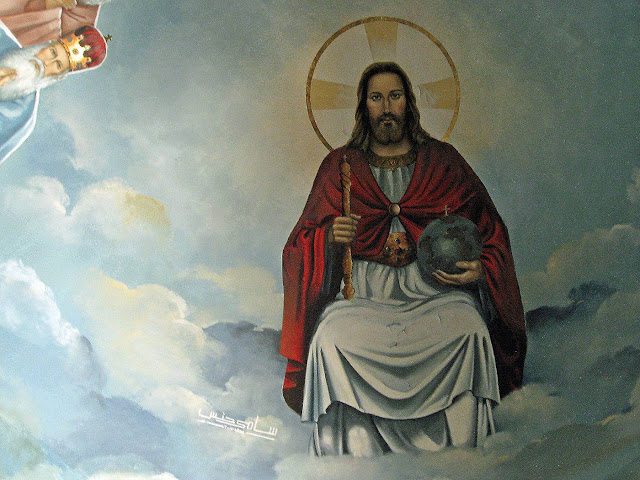Its nave is roofed with 21 cupolas, a design feature of Coptic church architecture that arose due to a lack of wood in Egypt. Entering, I was floored by the power of the images gracing the domes. Each cupola tells two stories. All of the images are dated to 2007 and all are painted by maestro Samy Henes. In a country with high illiteracy rates, I could easily imagine monk priests referring to the images high above the seated faithful during their sermons. Certainly, the images radiate with the power of the stories.
As Jesus' first miracle, the wedding at Cana is celebrated with a minor feast in the Coptic church. In their ancient calendar, it is celebrated on Tobah 13, which is approximately January 12th. Copts believe "Our Lord changed the water into wine, as His first miracle, at the wedding in Cana of Galilee, confirming His eagerness for our attaining the heavenly wedding, and granting us the wine of His exceeding love."
Monasticism was born in Egypt. From the 5th century A.D. onwards several monastic communities were established in the desert, particularly here in Upper Egypt. Certainly the image of Jacob's ladder would inspire the monks. For just as Jacob exclaimed so might they: "Surely, the Lord is in this place, and I did not know it! I thought that I was all alone, but God has been with me. This place is the house of God; it is the gate of heaven!" (Book of Genesis 28) Furthermore, since at least the third century A.D., Jacob's ladder is interpreted as the ascetic ladder that the soul climbs on Earth, with the steps representing increasing virtue used to ascend to heaven.
Christ is enthroned in majesty within the central copula. To me, the world seems to weigh somewhat heavy in His hand.
He is encircled by the popes of the Coptic Orthodox Church of Alexandria, each one recognizable. The current pope, His Holiness Pope Shenouda III, chose to live in the solitude of the desert as a monk when he was 31 and he has been instrumental in reviving Coptic monasticism since the 1970s. Hundreds of young men and women have reestablished monasteries and convents the length of Egypt. In the bleakness of the desert, their faith blooms.
WHERE TO FIND ME
View Larger Map
| GETTING THERE | USEFUL INFO SOURCES |
|---|---|
| Drive North from the main West Bank checkpoint to the sign indicating a left turn to Sheikh Tayb Saha village. Follow this road out to the desert Luxor-Qena highway. You will pass the large monastery of St. George on east side of the road and the domes of Deir el Malek on the west side. After 44.5 km from entering the desert, the entrance to the modern monastery of St. George at el Ballas is located close to the highway. | Coptic Church website: Coptic Orthodox Church Network |
| Artist Samy Henes' website: Welcome | |
| Wikipedia article: Coptic Architecture | |
| Tour Egypt article: The Christian Monasteries Near Naqada by Jimmy Dunn |






No comments:
Post a Comment